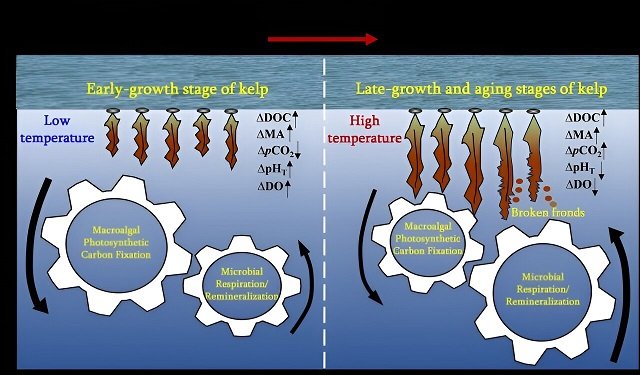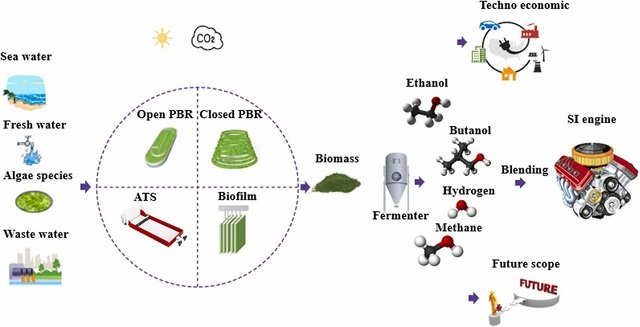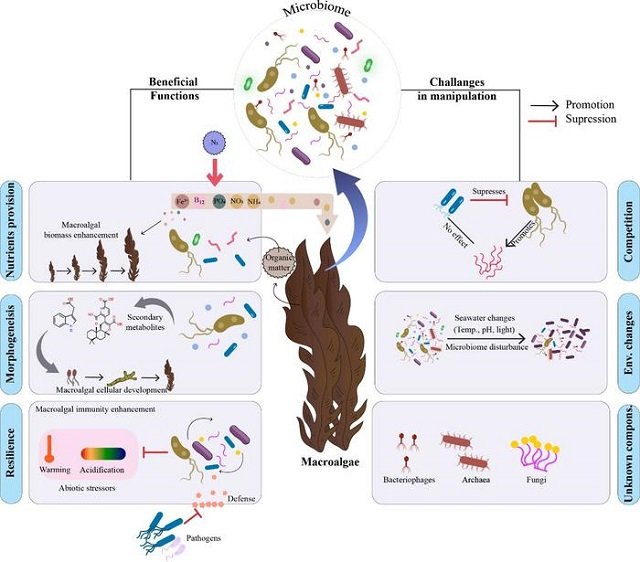
Marine algae or macroalgae are primary producers in coastal systems, and various scientific publications emphasize the significant role they play in carbon sequestration in the ocean.
Depending on climate scenarios, seaweed farming is often highlighted as a promising solution for climate change mitigation due to its ability to absorb carbon dioxide (CO2) through photosynthesis.
In general, seaweed cultivation is believed to turn seawater into a CO2 sink due to carbon fixation through macroalgae photosynthesis. However, little attention has been paid to the fact that seaweed farming environments can sometimes become a source of CO2 rather than a sink.
However, a recent study suggests that this practice may have a more nuanced impact on ocean carbon dynamics, acting as both a sink and a source of CO2 depending on the growth stage of the algae.
Researchers from the Qingdao Institute of Bioenergy and Bioprocess Technology, Qingdao University, Xiamen University, among other academic institutions, published a study providing empirical data and information on the CO2 sink function and environmental effects of cultivating the seaweed “Kelp” (Saccharina japonica).
Carbon Fixation and Release
The study, conducted in China, focused on the cultivation of marine algae, a type of large brown algae. The researchers carried out eight field investigations covering different growth stages of marine algae in China’s most intensive agricultural area (Sanggou Bay) to examine variations in organic and inorganic dissolved carbon systems in seawater, as well as microbial abundance, revealing the CO2 sink model under microbial regulation.
The researchers found that during the rapid growth stage, the algae acted as a strong CO2 sink, removing significant amounts from the surrounding seawater. This resulted in a decrease in dissolved CO2 (pCO2) and an increase in pH, creating a more favorable environment for marine life.
However, the positive effects were not permanent.
Stay Always Informed
Join our communities to instantly receive the most important news, reports, and analysis from the aquaculture industry.
As the algae matured and entered their aging stage, a dramatic shift occurred. The release of dissolved organic carbon by the algae boosted microbial activity, leading to increased respiration and CO2 production. This surpassed photosynthetic CO2 absorption, transforming seawater from a sink to a source of CO2. This process was accompanied by a decrease in pH and dissolved oxygen levels, indicating potential negative impacts on the local ecosystem.
Implications for Seaweed Farming Practices
Various studies have highlighted the potential of seaweed for organic carbon sequestration, suggesting that seaweed farming areas act as CO2 sinks and can provide refuge against ocean acidification.
Mature seaweed can rapidly induce seawater acidification and deoxygenation, turning the surrounding seawater environment into a CO2 source. The release of dissolved organic carbon by late-stage seaweed significantly increased, supporting increased microbial abundance and respiration, manifested by a notable decrease in dissolved oxygen in seawater, ultimately leading to CO2 release exceeding photosynthetic CO2 absorption.
Likewise, the study’s results underscore the importance of timely harvesting in seaweed cultivation. Harvesting mature seaweed at its peak growth stage can maximize its carbon sequestration potential and minimize its environmental impact. This would require careful monitoring of algae growth and harvesting just before they enter the aging stage when they become a source of CO2.
In the same vein, researchers emphasize that “CO2 sink or source processes of seaweed farming are also closely associated with their buffering or exacerbating effects on coastal acidification, i.e., CO2 removal may lead to an increase in pH, while CO2 release may lead to a decrease in pH.”
Additionally, the study highlights the need for further research to fully understand the complex interaction between algae growth, carbon dynamics, and marine ecosystems. By optimizing harvesting practices and developing more sustainable farming methods, the full potential of seaweed as a carbon sequestration tool can be harnessed.
Conclusion
While seaweed farming holds immense promise for mitigating climate change, its impact on ocean carbon dynamics is not straightforward.
“The release of dissolved organic carbon by seaweed in the late growth stage increased significantly, supporting the improvement in microbial abundance and respiration, manifested by the notable decrease in dissolved oxygen in seawater, ultimately leading to CO2 release exceeding photosynthetic CO2 absorption,” conclude the researchers.
Furthermore, the study’s results enable researchers to recommend that mature cultivated seaweed should be harvested promptly to better utilize its carbon sequestration function and environmental benefits, which is crucial for the rational management of seaweed farming.
The study demonstrates the pivotal role of harvest timing in maximizing the carbon sequestration potential of seaweed farming and minimizing its environmental footprint. By adopting these insights, seaweed cultivation can significantly contribute to building a more sustainable future.
The study was funded by the National Natural Science Foundation of China, National Key Research and Development project of China, Fujian Provincial Key Laboratory of Marine Ecological Conservation and Restoration, among others.
Contact:
Yongyu Zhang
Qingdao Institute of Bioenergy and Bioprocess Technology
Chinese Academy of Sciences
Qingdao 266101, China.
Email: zhangyy@qibebt.ac.cn
Reference:
Tianqi Xiong, Hongmei Li, Yubin Hu, Wei-dong Zhai, Zhe Zhang, Yi Liu, Jihong Zhang, Longfei Lu, Lirong Chang, Liang Xue, Qinsheng Wei, Nianzhi Jiao, Yongyu Zhang. Seaweed farming environments do not always function as CO2 sink under synergistic influence of macroalgae and microorganisms, Agriculture, Ecosystems & Environment, Volume 361, 2024, 108824, ISSN 0167-8809, https://doi.org/10.1016/j.agee.2023.108824.
Editor at the digital magazine AquaHoy. He holds a degree in Aquaculture Biology from the National University of Santa (UNS) and a Master’s degree in Science and Innovation Management from the Polytechnic University of Valencia, with postgraduate diplomas in Business Innovation and Innovation Management. He possesses extensive experience in the aquaculture and fisheries sector, having led the Fisheries Innovation Unit of the National Program for Innovation in Fisheries and Aquaculture (PNIPA). He has served as a senior consultant in technology watch, an innovation project formulator and advisor, and a lecturer at UNS. He is a member of the Peruvian College of Biologists and was recognized by the World Aquaculture Society (WAS) in 2016 for his contribution to aquaculture.




